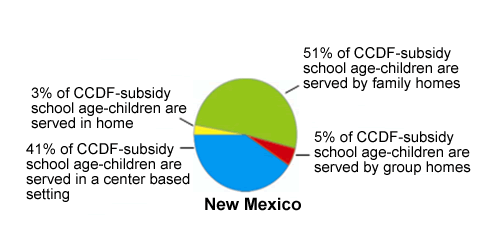|
The Afterschool Investments project has developed profiles for each state to provide a snapshot of the "state of afterschool," as well as an opportunity to compare afterschool activities across the country. This profile provides key data and descriptions of the afterschool landscape, which includes a range of out-of-school time programming that can occur before and after school, on weekends, and during summer months. It is designed to serve as a resource for policymakers, administrators, and providers.
Quick Facts
Demographics
| Total population: |
1,954,599 |
Number of children ages 5-12:
|
218,879 |
| Percent of population: |
11.2% |
Percent of students eligible for free and reduced-price lunch:
|
56.1% |
Percent of K-12 students in Title I "Schoolwide" schools:
|
47.3% |
For more demographic information, visit http://nccic.acf.hhs.gov/statedata/statepro/index.html
Child Care and Development Fund (CCDF)
• CCDF Administrative Overview
Administering agency: |
New Mexico Children, Youth, and
Families Department, Child Care Srvcs. Bureau |
Total FFY06 federal and state CCDF funds: |
$45,353,511 |
FFY06 total federal share: |
$37,948,526 |
FFY06 state MOE plus match: |
$7,404,985 |
FFY06 School Age & Resource and Referral Targeted Funds: |
$160,910 |
FFY06 Tribal CCDF Allocation:
|
$2,501,304 |
FFY05 Total Quality Expenditures: |
$3,337,779 |
Percent of children receiving CCDF subsidies who are ages
5-12: |
43.1% |
• Settings

Where CCDF-Subsidy school age-children are served:
| In a center based setting |
41% |
| By group homes |
5% |
| By family homes |
51% |
| In home |
3% |
• Uses of CCDF Targeted Funds and Quality Dollars for Afterschool
"Resource and referral and school-age" targeted funds:
Funds may support higher reimbursement rates paid to providers serving school age children.
Other quality activities:
Data not available
• Provider Reimbursement Rates
Label assigned by state for school-age rate category: |
6 years or more |
Maximum rate for center-based school-age category: |
$337.11/month |
Notes: Rates vary by metro and rural areas. Rates for metro given. |
Standardized monthly center-based school-age rate: |
$253 |
Are separate subsidy rates offered for part-time and full-time care? |
Yes |
Tiered Reimbursement Rate System:
Rates are higher for infant, toddler, and afterschool rates to reflect high demand for these services. Rates are also higher for accredited providers.
Temporary Assistance for Needy Families (TANF) and Child Care
FFY05 state TANF transfer to CCDF: |
$29,582,094 |
FFY05 TANF direct spending on child care:
|
$0 |
Program Licensing and Accreditation Policies
| Are there separate licensing standards governing the care of school-age children? |
Yes |
Are there specialized requirements for center-based care for school-age children? |
Yes |
Ratio of children to adults in school-age centers: |
15:1 |
Number of National AfterSchool Association (NAA) accredited programs:
|
8 |
21st Century Community Learning Centers (21st CCLC)
FY06 state formula grant amount: |
$8,071,240 |
Most recent competition: |
May 2004 |
Applications funded: |
10 |
Total first year grant awards: |
$2,929,498 |
| Fiscal agent type: |
100% school district
0% other |
| Licensing required? |
No |
Return to top
Statewide Initiatives
-
Statewide Positive Youth Development Focus. In 1999, efforts to create a designated youth development trust fund with New Mexico’s tobacco settlement money highlighted the need for coordination and collaboration in the youth development field. Spurred by the McCune Charitable Trust, the Daniels Fund and the NM Community Foundation, a cross-section of public and private stakeholders laid the groundwork for a statewide youth development intermediary, now called the New Mexico Forum for Youth in Community (NMFYC). In 2003, the Forum garnered support from the C.S. Mott Foundation and from local foundations to expand on the work of the current NM Out-of-School Time Network. The Forum targets support to youth-serving organizations through training, technical assistance, policy, data coordination, communications, and resource development efforts. Regional point organizations assure statewide input. The Forum supports Network activity for more than 200 groups and individuals.
-
Out of School Time Legislation. In the 2000 and 2003 sessions, the state legislature enacted memoranda commissioning a study of public investment in of afterschool programs in the state. The Children, Youth, and Families Department and the Public Education Department led efforts to identify state dollars being expended to support organizations that operate out-of-school time programs. The 2004 summary report outlined state investment for child care services, workforce development, substance abuse prevention, 21st Century Community Learning Centers, tutoring services, and meal and snack reimbursements totaling over $42 million. Ongoing assessment of findings and recommendations will continue in 2005 and 2006. Analysis and critical findings are available at www.nmforumforyouth.org. In April 2005, the New Mexico legislature voted to create the Next Generation Fund, which will get $2 million in seed money to be shared with the state’s Children's Trust Fund to leverage private funding for youth development and afterschool programs. In addition, the New Mexico Children, Youth, and Family Department provided funding to conduct a statewide program inventory of all out-of-school time programs that would create a map of extended learning opportunities for children and youth.
-
School Age Care and Family Support Program. The New Mexico Human Services Department, in conjunction with the Public Education Department, allocates a portion of federal Temporary Assistance for Needy Families (TANF) block grant funds to the School Age Care and Family Support Program. The program, which totaled $2.4 million in FY2003, provides academic enrichment and arts and recreation activities to students aged 5-8 whose parents are in the New Mexico Works/TANF program. Begun in 1999, the program serves over 3,000 students at 70 sites before and afterschool and during breaks. Public elementary schools apply through their districts for awards and can partner with nonprofit community-based agencies, community colleges, or universities. Programs are literacy/ arts based and must include parental involvement, as well as meet state education standards. The Public Education Department contracts with agencies such as the Museum of New Mexico and the Santa Fe Opera to provide arts programming and provides training and technical assistance to providers through workshops, monitoring visits, and publications.
-
Obesity Prevention Initiative. The Governor appropriated $475,000 in 2005 and $2,000,000 in 2006 to the Public Education Department for obesity prevention, of which $225,000 in 2005 and $165,000 in 2006 was utilized for Before and After School Nutrition and Physical Activity Programs. These funds were distributed through a competitive Request for Application to elementary schools, and were used to sustain existing programs and add a pilot for a program that includes tutoring, nutrition and physical activity components.
-
Children’s Cabinet. Governor Bill Richardson created the Children’s Cabinet in 2003 to increase interaction among agencies dealing with children and youth. Chaired by Lieutenant Governor Diane Denish and consisting of 11 state cabinet secretaries and a youth policy director, the Cabinet streamlines services and track health, education, safety, and economic indicators related to child well-being. The Cabinet looks across the developmental spectrum from ages 0-24 with the goal of addressing the multiple services and systems that support successful children and youth. The Cabinet became a permanent part of state government in 2005. New Mexico’s Youth Alliance, a project of the Children’s Cabinet and the Forum, convenes 112 youth age 14-19 to provide input on state policy and to contribute to a statewide youth report to the Governor, Children’s Cabinet, and State Legislature.
-
New Mexico Youth Initiative. The New Mexico Community Foundation was awarded a five-year, $5.2 million grant from the W.K. Kellogg Foundation for a statewide Youth Initiative. The Initiative will fund promising youth development practices at multiple established youth-serving nonprofit organizations, allowing grantees to support replication of their strategies. Regional incubators for positive youth development practice will help build capacity throughout the state. The NM Forum for Youth in Community is a key partner in the Initiative, providing an infrastructure to access youth development practices and principles across a variety of settings, including after-school.
-
State Demonstration Project. Launched by America’s Promise Alliance, this state project is designed to facilitate collaboration between existing public and private partnerships, increase awareness about child care, and increase funding for Alliance partners’ state affiliates. It is funded by a $20,000 grant from America’s Promise and is one of five nationwide.
Return to top
Notable Local Initiatives
-
Youth Development Inc. (YDI). YDI, founded in 1971, is a nationally and internationally recognized youth service organization that provides educational, developmental, and humanitarian assistance to effectively improve the life outcomes of New Mexico’s children, youth and families in need by helping them find and develop their full potential. YDI's programs include tutoring, afterschool activities, gang intervention, school drop-out prevention, family counseling services, emergency shelter, youth sports, internships, scholarships, parenting skills, leadership development, public housing assistance, community corrections, GED studies, early childhood education, and substance abuse and AIDS education. Through these programs, YDI serves more than 20,000 clients each year.
-
City of Albuquerque’s Middle School Cluster Initiative. The initiative provides support to elementary and middle school afterschool programs in the Albuquerque, NM. These programs target students who are at risk and are unsupervised during the before and after school hours. The programs encourage the children and youth to learn, play and develop their talents in a properly supervised environment. School teachers, out-of-school time professionals, public and private partners, and other stakeholders, work together to contribute to the social, emotional, cognitive, and physical development of all children. There are about 13,000 students who receive the benefits.
Return to top
Statewide Organizations
National AfterSchool Association Affiliate:
New Mexico School Age Care Alliance
Children's Choice
6501 Lomas Blvd NE
Albuquerque, NM 87110
Phone: 505-296-2880
National School Age Care Alliance Affiliate:
New Mexico School Age Care Alliance
Family Resource and Referral
PO Box 3038
Roswell, NM 88202
Phone: 505-623-9438
Statewide Child Care Resource & Referral Network:
Family Resource & Referral, Inc
704 S. Sunset, Suite A
Roswell, NM 88203
Phone: 800-447-9000
Statewide Afterschool Network:
New Mexico Forum for Youth in Community
924 Park Avenue SW, Suite D
Albuquerque, NM 87102
Web: http://www.nmforumforyouth.org/
New Mexico Voices for Children
801 Encino Place NE, Suite F-21
Albuquerque, NM 87102
Phone: 888-671-KIDS
Web: www.nmvoices.org
Return to top
Additional Resources
State Child Care Administrators:
http://nccic.acf.hhs.gov/statedata/dirs/display.cfm?title=ccdf
State TANF Contacts:
http://www.acf.hhs.gov/programs/ofa/tanf-dir.htm
21st Century Community Learning Centers Contacts:
http://www.ed.gov/programs/21stcclc/contacts.html
Return to top
Notes and Sources
Demographics
Total population: Annual Estimates of the Population for the United States and States, and for Puerto Rico: April 1, 2000 to July 1, 2006, U.S. Census Bureau.
Number of children ages 5-12: Estimates of the Resident Population by Single-Year of Age and Sex for the United States and States: July 1, 2006, U.S. Census Bureau.
Percent of students eligible for free and reduced-price lunch rate: Numbers and Types of Public Elementary and Secondary Schools from the Common Core of Data: School Year 2005-06. U.S. Department of Education. Washington, DC: National Center for Education Statistics.
Percent of K-12 students in Title I "schoolwide" schools: Numbers and Types of Public Elementary and Secondary Schools from the Common Core of Data: School Year 2005-06. U.S. Department of Education. Washington, DC: National Center for Education Statistics. The federal Title I program provides funding to local school districts and schools with high percentages of poor children to help ensure that all children meet challenging state academic content and student academic achievement standards. Schools enrolling at least 40 percent of students from poor families are eligible to use Title I funds for schoolwide programs that serve all children in the school.
Child Care and Development Fund
The Child Care and Development Fund (CCDF) is the largest federal funding source for child care. States receive a funding allocation determined by formula and have broad flexibility to design programs that provide child care subsidies for low-income children under the age of 13 and to enhance the quality of child care for all children. Federal CCDF funding consists of mandatory, matching, and discretionary funds. Federal law requires that states spend at least 4 percent of their CCDF funds as well as additional targeted funds on activities to improve the quality and availability of child care. CCDF administrative data in this and the following sections is from the U.S. Department of Health & Human Services, Administration for Children and Families, Child Care Bureau, as reported by States, unless otherwise noted.
FFY06 state MOE plus match: In order to receive Federal matching funds, a state must expend Maintenance of Effort funds. Note that this does not capture actual expenditures, only the minimum required to draw down all available federal funds.
FFY06 Tribal CCDF Allocation: Federal CCDF Funds are awarded directly to Federally-recognized Indian Tribes.
FFY05 total quality expenditures: This data includes FY05 and prior year funds expended for quality from each of the CCDF funding streams (mandatory, matching, and discretionary) and expenditures under targeted funds for infant and toddler, school-age care and resource and referral. This figure provides information obtained from state financial reports submitted for FY05.
Uses of CCDF Targeted Funds and Quality Dollars for Afterschool: Portions of CCDF discretionary funds are targeted specifically for resource and referral and school-age child care activities as well as for quality expansion. (These funds are in addition to the required 4 percent minimum quality expenditure.)
Maximum rate for school-age category: Rate listed applies to center-based care; where rates vary by region or county, the rate for the most populated urban area is given.
Standardized monthly school-age rate: Monthly rate for a child, age 8, in care after school during the school year at a center in the most costly district for four hours per day, 20 days per month. Calculated (in the lowest tier of a tiered system) using information from the FY2006-2007. State CCDF Plan, including rate structures, as submitted to the U.S. Department of Health & Human Services, Administration for Children and Families.
Separate subsidy rates for part-time vs. full time and Tiered Reimbursement Rate Systems: U.S. Department of Health and Human Services. Child Care Bureau. Report of State Plans FY2006-2007.
Temporary Assistance for Needy Families (TANF) and Child Care
In addition to spending TANF funds directly on child care, a state may transfer up to 30 percent of its TANF grant to CCDF. Expenditures represent TANF funds spent in FY05 that were awarded in FY05 and prior years. Data from the U.S. Department of Health and Human Services, Administration for Children and Families.
Program Licensing and Accreditation Policies
States with separate school-age licensing standards and states with specialized requirements for child care centers serving school-age children: National Association for Regulatory Administration, 2005 Child Care Licensing Study, available at http://www.nara.affiniscape.com/displaycommon.cfm?an=1&subarticlenbr=104.
Ratio of children to adults in school-age setting: Data from the National Child Care Information Center (NCCIC), available at: http://nccic.acf.hhs.gov.
Number of NAA-accredited programs: Data from the National AfterSchool Association, March 2007, available at: http://www.naaweb.org.
21st Century Community Learning Centers
The No Child Left Behind Act of 2001 converted the 21st Century Community Learning Centers’ authority to a state formula grant. In past years, the U.S. Department of Education made competitive awards directly to school districts. Under the reauthorized law, funds flow to states based on their share of Title I, Part A funds. States use their allocations to make competitive awards to eligible entities. Data from the U.S. Department of Education 21st Century Community Learning Centers Office and the 21st CCLC Profile and Performance Information Collection System.
Return to top
The Child Care Bureau awarded a technical assistance contract to The Finance Project and their partner, the National Governors Association Center for Best Practices, for the Afterschool Investments project. The goals of the Afterschool Investments project include:
- Identifying ways that state and communities are using Child Care and Development Fund (CCDF) subsidy and quality dollars to support out-of-school time programs, and sharing these practices and approaches with other states;
- Identifying administrative and implementation issues related to CCDF investments in out-of-school time programs, and providing information and context (about barriers, problems, opportunities) as well as practical tools that will help CCDF administrators make decisions; and
- Identifying other major programs and sectors that are potential partners for CCDF in supporting out-of-school time programs and providing models, strategies, and tools for coordination with other programs and sectors.
Contact Us:
Email:
afterschool@financeproject.org
Web:
http://nccic.acf.hhs.gov/afterschool/
The Finance Project
1401 New York Avenue, NW
Suite 800
Washington, DC 20005
Phone: 202-587-1000
Web: www.financeproject.org
National Governors Association
Center for Best Practices
444 North Capitol Street, NW
Washington, DC 20001
Phone: 202-624-5300
Web: www.nga.org
The Afterschool Investments project’s State Profiles are designed to provide a comprehensive overview of noteworthy State and local initiatives across the country. Inclusion of an initiative in the Profiles does not represent an endorsement of a particular policy or practice.
|





